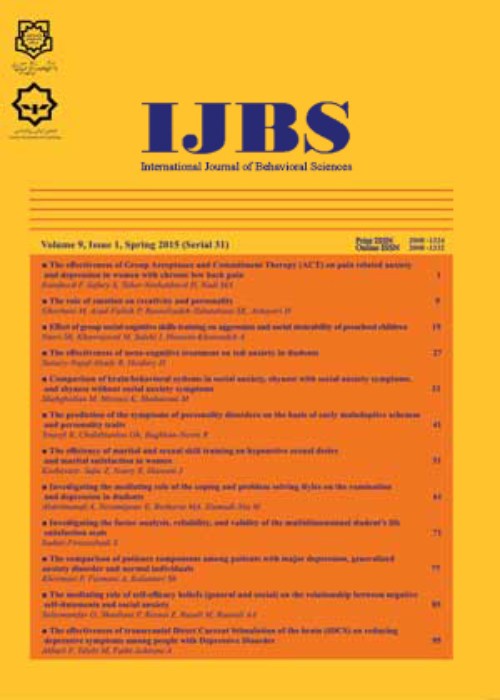فهرست مطالب

International Journal of Behavioral Sciences
Volume:11 Issue: 2, Summer 2017
- تاریخ انتشار: 1396/06/25
- تعداد عناوین: 5
-
-
Pages 44-48IntroductionObesity causes multiple problems that may potentially lead into physical diseases and mental health problems. The present study aims at investigating the effect of lifestyle change programs on the improvement of subjective well-being of obese females.MethodThis study is a quasi-experimental research and falls into a pre-test and post-test design with a control group. The statistical population of the study includes all the obese females who had attended diet and nutrition clinics in Sanandaj during 2016. Convenience sampling was used in order to select the total 20 sufferers who were randomly assigned into experimental and control groups (each one with 10 patients). The experimental group participated in 10 sessions of lifestyle change program, whereas the control group received no intervention. Subjective Well-being Scales were administered to both groups before and after the implementation of the program. Multivariate covariance test was applied in order to analyze the data.ResultsThe findings show a decrease in negative emotions and an increase in life satisfaction and also positive emotions are significant (P≤0.01). It suggests that changing the individual's lifestyles significantly affects such factors.ConclusionIt is worth mentioning that the findings of the present study have practical implications as far as decreasing mental health problems and increasing the mental health of obese people are concerned.Keywords: Lifestyle, Subjective Well-being, Obesity
-
Pages 49-54IntroductionMultiple sclerosis (MS) is the most common neurologic disorder in young and middle-aged individuals worldwide. This disorder can afflict any part of the Central Neural System (CNS), optic nerves, brainstem, cerebellum and the spinal cord. The present study was an attempt to investigate the interactive role of reinforcement sensitivity (BIS/BAS) and personality traits in predicting the severity of the MS disease.MethodsThe study was a correlational enquiry in which 162 patients with MS were selected by purposive sampling in Shiraz, Iran. The data were collected using NEO Five Factor Inventory (NEO-FFI), Jackson-5 scale, and Expanded Disability Status Scale (EDSS) questionnaires and were finally analyzed using Pearson correlation coefficient and multiple regression. The SPSS software version 21 (SPSS, Inc., Chicago, IL, USA) was used for the statistical analysis.ResultsThe results showed that indicators of personality traits (F chanch = 10.562, pConclusionsThe results indicated that the interaction between personality traits and reinforcement sensitivity factors increases the risk of the growth of the MS disease.Keywords: Multiple Sclerosis, Reinforcement Sensitivity, Personality Traits, Expanded Disability Status of MS
-
Pages 55-60IntroductionHypochondria is a prevalent disorder which is resistant to diagnosis and treatment. The present study has aimed to develop and validate a new behavioral cognitive-metacognitive model, which explains the hypochondria disorder.MethodsThe present research used a descriptive and correlational research method with a structural equations design. In the current study, a comprehensive and detailed definition of hypochondria disorder was suggested and then the conceptual model was proposed. Finally, the model developed with the help of structural equations was tested through the AMOS Graphic software.ResultsResults of the structural equation model indicated that the behavioral cognitive-metacognitive model is capable of explaining the hypochondria disorder. Moreover, the results of the general fit indexes of the structural equations model suggested that the developed model has the goodness of fit indexes with the sample data and is closely related with theoretical hypotheses.ConclusionThe suggested model in this study had multidimensional focuses on all behavioral-cognitive and metacognitive aspects. Furthermore, the model considered all the three dimensions to be in an interacting relationship (it did not consider them to be separate or conflicting concepts).Therefore, it was considered to be a novel explanatory model. This model might promote future researches regarding hypochondriac disorder and facilitate case formulations and relevant clinical treatments.Keywords: Modeling, Hypochondria Disorder, Behavior, Cognition, Metacognition
-
Pages 61-66IntroductionThe present study was aimed to predict social intimacy by early maladaptive schemas and attachment styles.MethodThis descriptive study was conducted on high school students. In the study, about 400 subjects were selected as the sample through multistage cluster random sampling technique. Data collection was done by using Young's Early Maladaptive Schema Questionnaire, Hazan & Shaver Attachment Style Questionnaire, and the Miller Social Intimacy Scale. The data were analyzed by Descriptive statistics, Pearson correlation and enter regression analysis.ResultsThe results showed that early maladaptive schemas and insecure attachment styles are not able to predict social intimacy. This is while, secure attachment styles have the ability to predict social intimacy and that; social intimacy has a significant negative relation to insecure attachment styles and early maladaptive schemas.ConclusionAccording to the research findings, secure attachment style is a good predictor of social intimacy. It seems necessary to pay attention to secure attachment style in order to increase social intimacy.Keywords: Early Maladaptive Schemas, Attachment Styles, Social Intimacy
-
Pages 67-73IntroductionDecision- making as an executive process, consists of a wide range of inputs such as conditioning based on past experiences, sensory and emotional responses, and the anticipation of future goals. The present study aims to investigate the effects of cognitive/executive functions on decision making competence in organizational settings.MethodThe sample of this research consisted of 430 managers from 5 industrial companies in Iran who were selected by random sampling method. The instruments which were used in this study were the Cognitive Ability Questionnaire and the Adult Decision Making Competence (A-DMC) tasks. Structural Equation Modeling (SEM) was used through AMOS-22 for data analysis.ResultsThe results indicated that cognitive/executive functions planning, cognitive flexibility, inhibitory control, & social cognition- had significant effects on 5 decision making competencies mediating by applying decision rules in the current model.ConclusionTo conclude, from our point of view, different decision-making tasks are separately related to cognitive/executive functions specifically at managerial frameworks. Thus, the current study indicated which cognitive control processes are most operative in the successful performance of managers on different decision tasks. If different executive functions are mainly needed for the successful accomplishment of some decision-making tasks, training these functions in organizations may improve some facets of decision-making performance.Keywords: Cognitive Functions, Decision-making Competence, Organizational Setting


